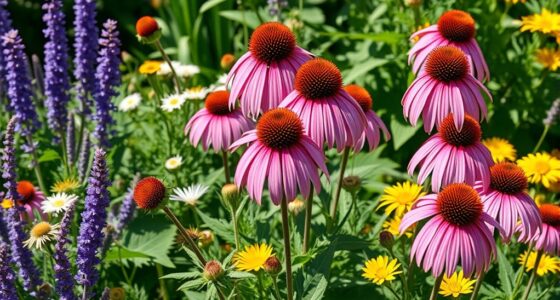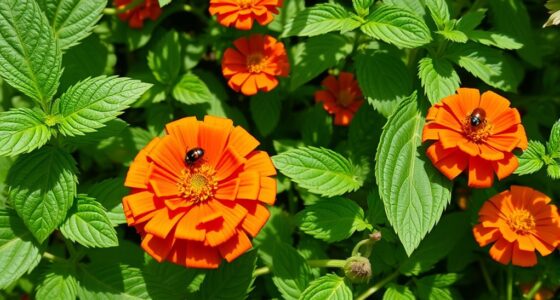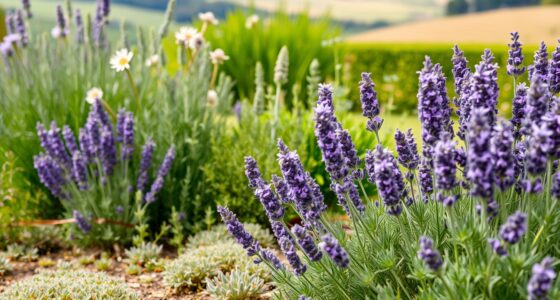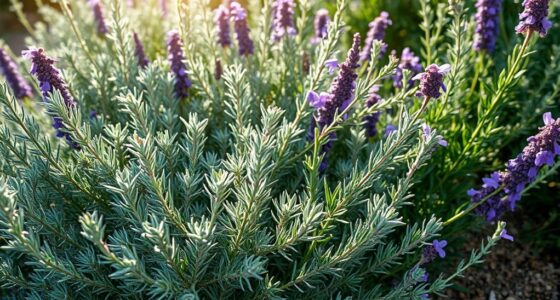Have you ever watched your garden bloom with the joy of companionship? Just like in life, plants thrive when they surround themselves with the right friends. When you grow celery, discovering its perfect partners can transform not only its growth but your entire gardening experience. The beauty of companion planting for celery lies in nurturing a bond between various plants that enhances flavors, deters pests, and builds a thriving ecosystem in your garden. You’ll find that the best plants to grow with celery are not just companions; they are your allies, working together to create a bountiful harvest that you can take pride in. So, let’s delve into this wonderful world where plants support one another, making your garden more productive and enjoyable.
Key Takeaways
- Companion planting can greatly enhance your celery’s growth and flavor.
- Certain plants naturally deter pests that affect celery.
- Understanding the relationships between plants can optimize your garden space.
- Selecting the right companions can improve soil health overall.
- Working with nature through companion planting fosters a thriving ecosystem.
Understanding Celery’s Growth Requirements
To cultivate healthy celery, it’s essential to grasp its growth needs. This vegetable has specific celery growth requirements that cater to its well-being and development. A successful harvest depends on providing the right environmental conditions, including soil type, sunlight exposure, and consistent moisture levels.
Ideal Soil Conditions
For optimal growth, celery soil preferences lean towards well-drained, nutrient-rich environments. Incorporating organic matter elevates soil health, ensuring it retains adequate moisture. Aim for a pH level between 6.0 and 7.0 to foster a thriving garden. Regular soil amendments such as compost can support these conditions, leading to a robust yield.
Sunlight Needs
Sunlight is a crucial factor for growing celery effectively. Celery typically requires at least 6 hours of direct sunlight daily. Providing partial shade during the hottest times of the day can help prevent stress, allowing your plants to flourish. Understanding your area’s sunlight patterns can guide you in positioning your celery plants for maximum benefit.
Watering Techniques
Maintaining proper moisture is vital to celery’s success. Celery watering needs dictate that the soil remains consistently moist but never waterlogged. Utilizing mulch can help conserve moisture and minimize weed competition. Establishing a regular watering schedule will support healthy stalk development, ensuring an abundant crop.

Benefits of Companion Planting with Celery
Engaging in companion planting with celery introduces a variety of *benefits of companion planting* that enhance not only the growth of celery but also the overall garden ecosystem. This practice allows you to focus on specific advantages like flavor enhancement, pest control, and improved soil health, creating a thriving environment for your plants.
Enhancing Flavor and Growth
One significant aspect of companion planting is its potential for *celery flavor enhancement*. By planting celery alongside compatible plants, you can improve the taste and yield of your harvest. Certain pairs can enrich the soil, increase moisture retention, and contribute to the overall vitality of your garden, ensuring that your celery achieves its full flavor potential.
Pest Control Benefits
Another advantage lies in the *pest control with companion plants* that naturally repel harmful insects. Incorporating plants that deter pests such as aphids and carrot flies can protect your celery from damage. This strategy not only safeguards the plants but also minimizes the need for chemical interventions, promoting a healthier garden atmosphere.
Soil Health Improvements
Companion planting with celery significantly enhances soil health. Specific plants contribute to nitrogen fixation and boost microbial activity, enriching the growing medium. This cooperative relationship fosters resilience and vitality among your plants, creating a more sustainable gardening practice.
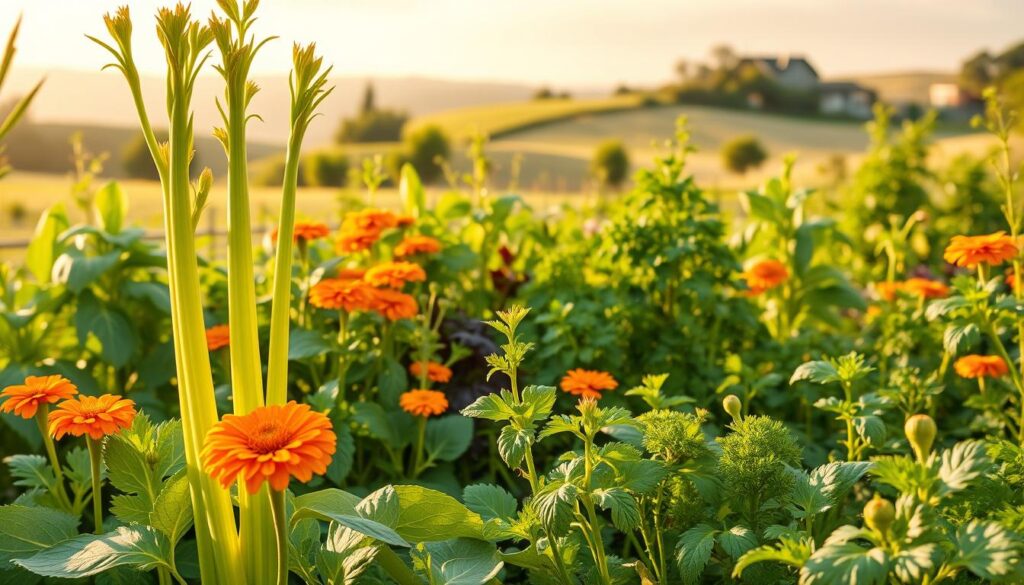
Ideal Companion Plants for Celery
When considering the best companion plants for celery, it’s essential to choose those that enhance its growth, deter pests, and complement its needs. Celery allies can play crucial roles in your garden, resulting in a healthier and more productive growing environment. Here are a few exceptional celery plant companions to consider for your garden.
Onions: A Natural Ally
Onions work well as celery companions due to their strong scent, which repels various pests that often target celery. This includes nuisances like aphids and carrot flies. By planting onions near your celery, you provide a natural form of pest control that benefits both crops.
Tomatoes: A Nutrient Booster
Tomatoes serve as excellent celery allies, promoting growth and improving nutrient uptake. Their presence can also deter pests like cabbage worms, making them valuable companions. Together, these plants create a thriving ecosystem that maximizes the health of your garden.
Spinach: The Shade Provider
Spinach thrives alongside celery as both plants share similar soil and water requirements. Celery provides partial shade for spinach, allowing it to flourish. This symbiotic relationship exemplifies the advantages of selecting the right celery plant companions, leading to a more vibrant garden.

| Companion Plant | Benefits | Pest Control |
|---|---|---|
| Onions | Repel pests and improve growth | Aphids, carrot flies |
| Tomatoes | Enhance nutrient uptake | Cabbage worms |
| Spinach | Provides shade and shares water needs | N/A |
Plants to Avoid Near Celery
When planning your garden, it is crucial to consider the potential celery plant conflicts. Some plants may interfere with the healthy growth of celery, making it essential to identify bad companions for celery. Understanding what to avoid can significantly enhance the success of your garden.
Carrots: Competition for Nutrients
Carrots, parsnips, and turnips are part of the same family as celery. When planted together, they compete for essential nutrients in the soil, leading to poor development for all. It’s wise to keep these root vegetables at a distance to ensure your celery thrives.
Brassicas: Growth Inhibition
Brassicas, such as cabbage, broccoli, and Brussels sprouts, can inhibit the growth of celery. These plants often release chemicals into the soil that may hinder celery’s ability to take up the necessary nutrients. To minimize potential issues, avoid planting brassicas near your celery.
Aromatic Herbs: Potential Conflicts
Aromatic herbs like parsley and cilantro can create competitive signals that confuse interactions with celery. This can lead to unexpected growth challenges. To maintain a harmonious garden environment, consider steering clear of these herbs when cultivating your celery.
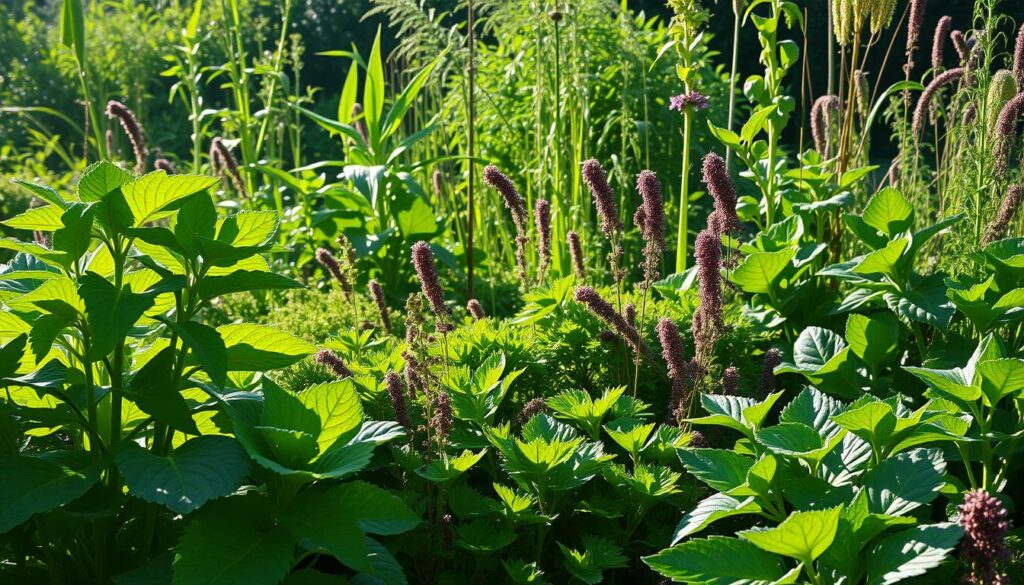
| Plant Type | Reason to Avoid |
|---|---|
| Carrots | Compete for nutrients and space |
| Brassicas | Release growth-inhibiting chemicals |
| Aromatic Herbs | Confuse plant interactions |
Attracting Beneficial Insects
Creating a balanced ecosystem in your celery garden can significantly enhance its health. Attracting beneficial insects to celery serves as a natural pest control for celery, reducing your reliance on chemical treatments. Introducing insect allies for celery, such as ladybugs and lacewings, helps protect your crops from harmful pests like aphids and whiteflies.
Ladybugs: Natural Pest Control
Ladybugs are renowned for their appetite for aphids, making them valuable allies in your garden. Encouraging their presence can lead to a remarkable reduction in pest populations. You can attract ladybugs by planting:
- Cosmos
- Nasturtiums
- Calendula
These attractive flowers offer shelter and food, increasing the likelihood of ladybugs visiting your celery plants.
Lacewings: Protecting Your Crops
Lacewings, often referred to as “aphid lions,” are another beneficial insect that helps control pest populations. Their larvae consume various pests that threaten your crops. To draw lacewings to your garden, consider planting:
- Yarrow
- Sweet alyssum
- Fennel
These plants not only attract lacewings but also contribute to a diverse ecosystem, enhancing the growth of your celery plants.
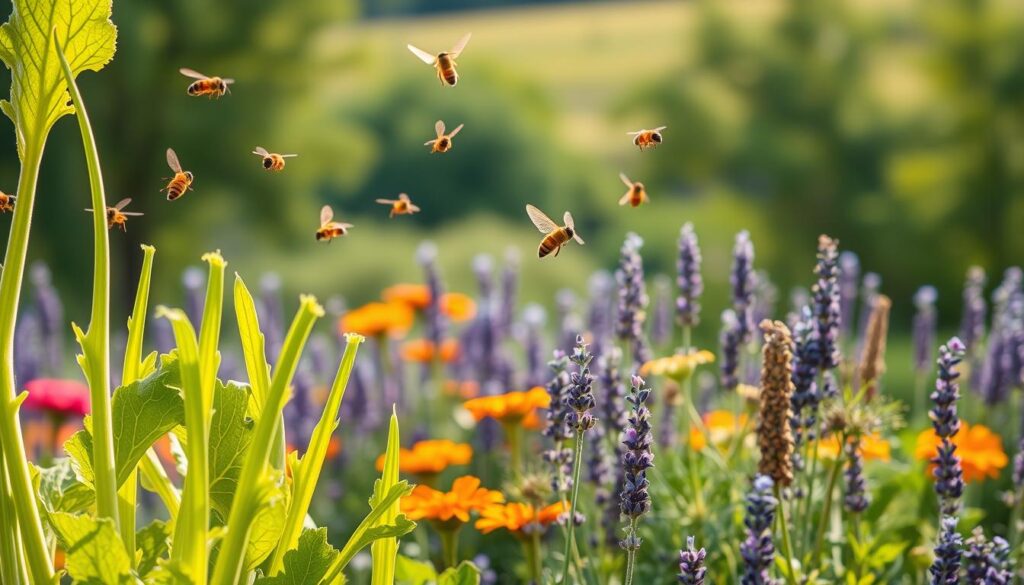
Herbs That Pair Well with Celery
Incorporating herbs that support celery can significantly enhance your garden’s vitality. Companion herbs for celery, such as basil and dill, offer a myriad of benefits that contribute to a thriving ecosystem. These herbs not only improve the health of your celery but also elevate the overall flavor and appeal of your garden.
Basil: Flavor and Growth Enhancer
Basil stands out as one of the best herbs for boosting celery growth with herbs. Known for its aromatic leaves, basil can enhance the flavor of celery while also serving as a deterrent against certain pests. When grown alongside celery, it creates a harmonious relationship that benefits both plants. The shared growing conditions mean that basil not only complements your vegetable garden but actively contributes to its health.
Dill: Attracting Pollinators
Dill is another exceptional choice when considering herbs that support celery. Its delicate flowers attract pollinators, which are essential for fruit and vegetable production. Planting dill near your celery encourages beneficial insects that promote healthy growth. This herb thrives in similar conditions, making it an ideal companion for creating a vibrant garden space.
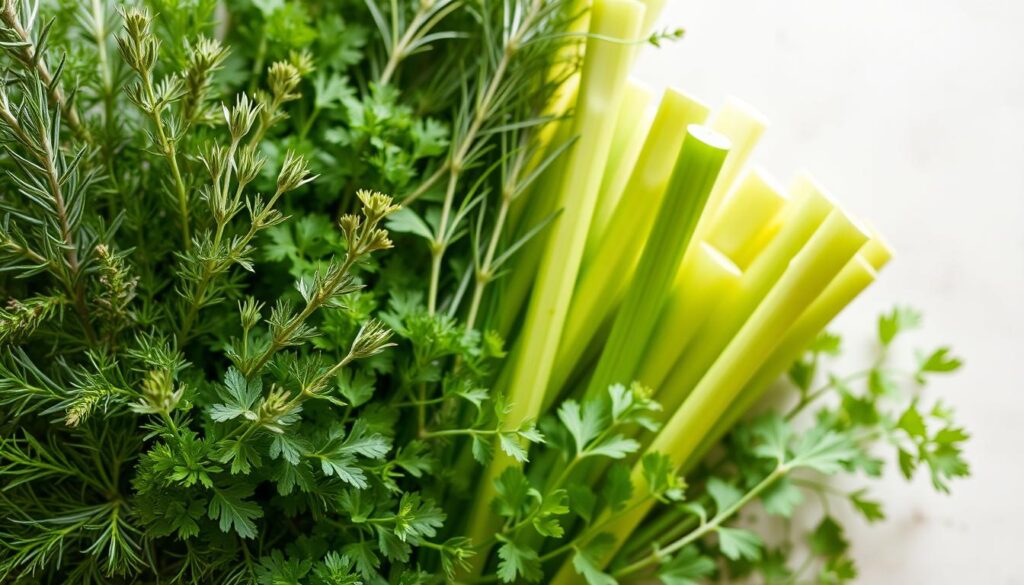
| Herb | Benefits | Growing Conditions |
|---|---|---|
| Basil | Enhances flavor, pest deterrent | Full sun, well-drained soil |
| Dill | Attracts pollinators, promotes healthy growth | Full sun, moderate moisture |
Vegetables That Thrive Next to Celery
When you consider planting vegetables with celery, you open the door to many synergies that can enhance your garden’s overall productivity. Certain crops not only complement celery’s growth but also help in utilizing space efficiently and preventing pest issues. Here are two standout vegetable companions for celery that can significantly contribute to boosting garden productivity.
Peppers: Nutrient Companions
Peppers make excellent partners for celery in the garden. Their growth habits and nutrient requirements align well, which means they do not compete for essential resources. Celery’s ability to repel certain pests creates a beneficial environment for peppers, allowing them to thrive. This natural relationship helps both crops flourish while maintaining a healthy balance in your garden.
Lettuce: A Perfect Ground Cover
Lettuce serves as an ideal ground cover for celery plants. As a low-growing crop, it maximizes space and minimizes weeds, which can otherwise compete for moisture and nutrients. Both lettuce and celery have similar watering needs, making them perfect for planting side by side. This combination not only enhances productivity but also leads to a more vibrant garden ecosystem.

Organic Practices for Companion Planting
Integrating organic practices into your gardening routine can significantly enrich your experience while enhancing the health of your plants. When practicing organic gardening with celery, methods like crop rotation and the use of natural pest deterrents prove essential. These strategies not only sustain your celery but also contribute to improving soil health organically.
Crop Rotation Benefits
Crop rotation involves alternating the types of crops planted in your garden each season. Implementing this sustainable gardening practice can help prevent the depletion of specific nutrients in the soil. Additionally, rotating crops interrupts the life cycles of pests and diseases that may accumulate in the soil over time. Your celery plants can thrive with the right nutrients while maintaining a balanced and healthy environment.
Natural Pest Deterrents
Companion plants can act as effective natural pest deterrents. Choosing certain plants alongside your celery can repel harmful insects, reducing the reliance on chemical pesticides. For example, marigolds are known to ward off nematodes and aphids. By incorporating these plants, you promote a healthier ecosystem, fostering sustainable gardening practices that benefit both your celery and other surrounding plants.
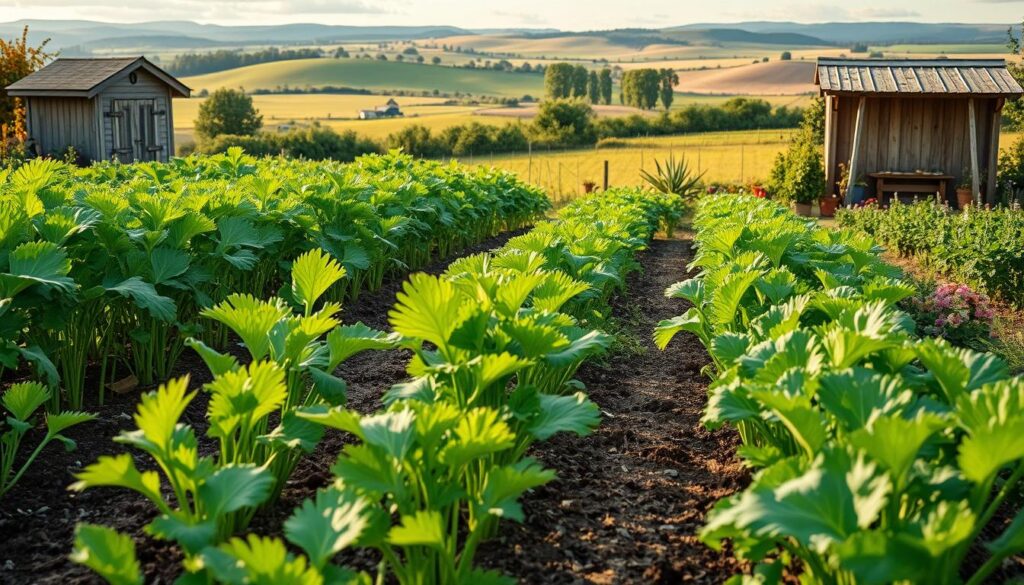
| Practice | Benefit |
|---|---|
| Crop Rotation | Prevents nutrient depletion and hinders pest life cycles. |
| Natural Pest Deterrents | Reduces need for chemical pesticides, promoting a healthy ecosystem. |
| Companion Planting | Enhances growth and flavor of celery, supports overall plant health. |
Timing Your Planting for Best Results
Timing plays a significant role in the success of your planting schedule for celery. You can often achieve remarkable results by aligning your planting with the seasons. Choosing the best planting times for celery can make all the difference in yield and flavor. Understanding when to plant in spring versus fall can lead your garden to flourish.
Spring vs. Fall Planting
Spring offers an ideal opportunity for planting celery, as the cooler temperatures support vigorous growth. Starting seeds indoors and then transplanting them outdoors after the last frost provides great results. On the other hand, fall planting can also be beneficial, especially in mild climates. A second harvest can occur if you time it right, taking advantage of the cooler fall weather that celery thrives in.
Overlapping Growth Cycles
Managing seasonal gardening for celery involves understanding the growth cycles of your companion plants. For example, you can sow quick-growing crops like spinach and lettuce. These can be harvested before celery fully occupies the space, allowing for a more productive garden layout. By planning for overlapping growth cycles, you maximize your garden’s output and make the most of your planting schedule for celery.

Using Companion Plants to Maximize Space
When you look to optimize your gardening efforts, implementing companion plants can play a significant role in maximizing garden space. This strategy not only enhances your crop yield but also promotes healthier growth among your plants. Combining vertical gardening with celery and smart interplanting techniques allows for a beautiful and productive garden, even if you have limited outdoor areas.
Vertical Gardening Techniques
Vertical gardening with celery utilizes trellises and supports for vining plants, which can create an appealing garden structure. This method enables you to grow taller plants, freeing up ground space for lower-growing crops like celery. The elevation provides better airflow and can even offer shade, helping to protect celery from the harsh midday sun. Home gardeners often incorporate pots or hanging containers to enhance vertical growth. Here are some benefits of this approach:
- Increased yield per square foot
- Improved sunlight exposure for all plants
- Reduced pest access to lower plants
Interplanting Strategies
Employing interplanting techniques helps in layering crops to optimize the garden’s vertical height. By carefully selecting crops that have different growth rates and requirements, you can create an efficient and harmonious planting layout. This approach ensures that sunlight reaches every plant while minimizing competition for essential nutrients. Consider the following best practices for successful interplanting:
- Choose complementary plants that thrive together.
- Plant taller crops on the north side of shorter crops to maximize sunlight exposure.
- Regularly monitor the growth progress to adjust plant placements if necessary.

| Technique | Description | Benefits |
|---|---|---|
| Vertical Gardening | Utilizing trellises for vining plants. | Maximizes space, improves airflow, and provides shade. |
| Interplanting | Layering different crops to optimize growth. | Ensures sunlight penetration and nutrient distribution. |
By merging these techniques, you can truly excel in maximizing garden space. Implementing vertical gardening with celery alongside interplanting strategies can lead to flourishing plants and a highly productive garden. Get creative with your combinations and witness the thriving landscape that unfolds!
Monitoring Your Garden’s Health
As you cultivate your garden, monitoring garden health becomes essential to ensure your plants thrive. Recognizing the signs of success in companion planting helps you discern whether your efforts are paying off. Vibrant leaves and a lack of pest infestation signify that your chosen companions support each other effectively.
Signs of Good Companion Planting
Observe your plants regularly for health indicators. Indicators of good companion planting include:
- Full developed foliage that showcases a rich green color
- A balanced growth rate across various plant types
- Minimal pest activity, indicating effective natural pest control
- Healthy root systems, which can be assessed by gently inspecting the plants
Adjusting for Poor Growth
If you notice stunted growth or evidence of pests, it may be time for adjusting planting strategies. Here are some steps to consider:
- Reevaluate your plant pairings to ensure compatibility.
- Introduce companion plants known for their pest-repelling properties.
- Change the layout to improve air circulation and sunlight exposure.
- Regularly assess soil quality and amend if needed.
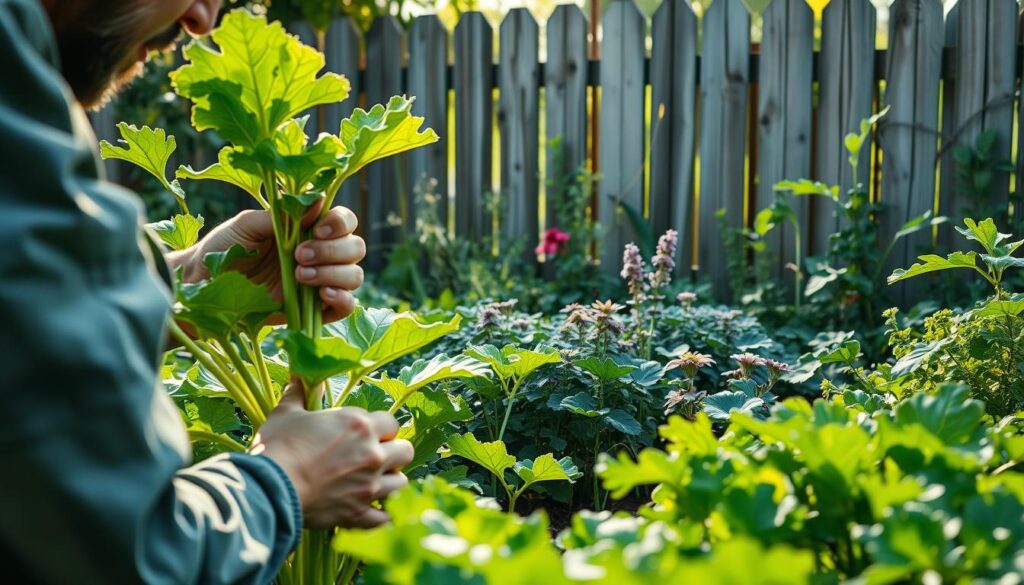
Learning from Your Garden Experience
Documenting your gardening experience through a planting journal proves to be a valuable tool. By keeping a record of your planting dates, weather conditions, and plant performance, you gain insights that can help refine your gardening techniques. Understanding these details will significantly enhance your future gardening endeavors.

Keeping a Planting Journal
A planting journal serves various purposes. It allows you to track your plants’ growth patterns, understand seasonal variations, and evaluate what strategies worked well. The planting journal benefits include the ability to reflect on past seasons, which enables you to make informed decisions for the next planting cycle. Regular entries facilitate a deeper connection to your garden, enhancing your overall gardening experience.
Observing Plant Interactions
Observing plant relationships in your garden can greatly enhance your knowledge of companion planting. By noting how different plants interact, you will learn which combinations thrive and which hinder growth. This observation fosters a better understanding of your garden ecosystem. Over time, you’ll recognize patterns that lead to more fruitful results, allowing you to adjust your strategies and improve your garden’s health.
Conclusion: The Art of Companion Planting
Creating a thriving garden is an art that combines knowledge, strategy, and patience. Companion planting success lies in your ability to select the right companions for your celery, allowing each plant to contribute to the overall health and productivity of your garden. By implementing best practices for celery crops and their companion plants, you can enjoy a garden that not only flourishes but also enhances your culinary experience with rich flavors and healthy yields.
Your Pathway to a Thriving Garden
As you cultivate your garden using companion planting techniques, you will notice improved growth and vitality. By strategically pairing celery with compatible plants like onions and tomatoes, you create an environment that supports pest control and promotes soil health. These thriving garden practices help ensure that your crops are resilient and better equipped to face challenges, ultimately leading to a bountiful harvest.
Celebrating Your Gardening Success
Every success in your garden, whether it’s a particularly vibrant celery stalk or an impressive yield, deserves to be celebrated. These moments not only signify your dedication but also reflect the effectiveness of your companion planting efforts. With each growing season, you will learn more about your garden’s dynamics, paving the way for continued gardening success that enriches your table and brings joy to your green space.


